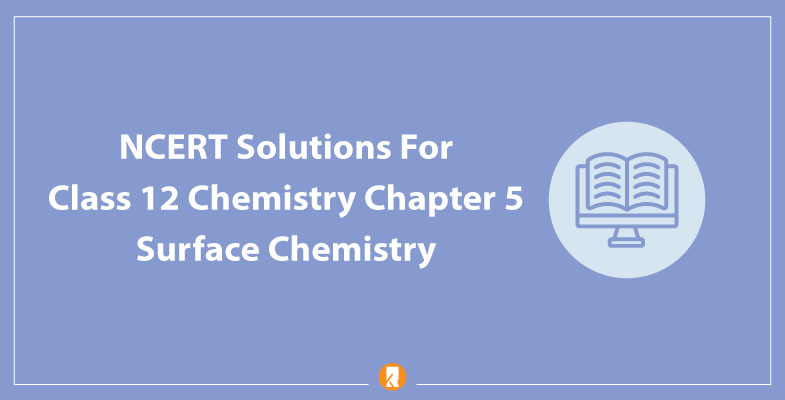NCERT Solutions For Class 12 Chemistry Chapter 5: It is a necessary study material for a thorough understanding of surface chemistry topics. The role of adsorption, types of adsorption, pressure effects, and temperature effects on the surface are all covered in the Surface Chemistry chapter. The Surface Chemistry Class 12 NCERT Solutions provide students with all of the chapter’s details, illustrations, and explanations. Read the complete article to download the Class 12 Chemistry Chapter 5 textbook solutions PDF.
NCERT Solutions For Class 12 Chemistry Chapter 5 PDF: Surface Chemistry NCERT Solutions
Surface Chemistry Class 12 Ncert Solutions PDF
Download Surface Chemistry NCERT Solutions PDF:
The NCERT solution for Class 12 Chemistry Chapter 5 includes answers to two sections: NCERT questionnaires and In-text questions. Students studying for their class 12 board exams should solve NCERT questions, as doing so would help them grasp the chapter better. You should strive to solve all of the NCERT questions presented at the conclusion of this chapter because questions from the NCERT books are sometimes posed directly in the examination by just changing the numerical numbers.
What will you get in Surface Chemistry Class 12 NCERT Solutions PDF?
The chapter on surface chemistry covers topics such as adsorption, catalysis, and colloids, which include emulsions and gels. After studying this chapter, you will be able to describe the interfacial phenomenon and its significance; define adsorption and classify it into physical and chemical adsorption; explain the mechanism of adsorption; explain the factors controlling adsorption from gases and solutions on solids; explain adsorption results on the basis of Freundlich adsorption isotherms; types of colloids.
Also, it will help you to answer the question on product molecules, colloidal particles, appreciate the role of catalysts in the industry; enumerate the nature of the colloidal state; describe the preparation, properties, and purification of colloids; classify emulsions and describe their preparation and properties; describe the phenomenon of gel formation; list the uses of colloids.
Subtopics of NCERT Solutions For Class 12 Chemistry Chapter 5
Subtopics that are included in the chapter are as follows-
- Adsorption (extent of adsorption, physical adsorption, adsorption increases, the magnitude of adsorption, terms adsorption, fresh adsorption, heat of adsorption, rate of adsorption, adsorption of gas, adsorption per gram, adsorption process)
- The distinction between Adsorption and Absorption
- Mechanism of Adsorption
- Type of Adsorption
- Adsorption Isotherms
- Adsorption from Solution Phase
- Applications of Adsorption
- Catalysis
- Homogeneous and Heterogeneous Catalysis
- Adsorption Theory of Heterogeneous Catalysis
- Shape-Selective Catalysis by Zeolites
- Enzyme Catalysis
- Catalysts in Industry
- Colloid
- Classification of Colloids (Aggregated Colloids)
- Classification Based on the Physical State of Dispersed Phase and Dispersion Medium
- Classification Based on the Nature of Interaction between Dispersed Phase and Dispersion Medium
- Classification Based on the Type of Particles of the Dispersed Phase, Multimolecular Colloid, Macromolecular Colloids, and Associated Colloids, lyophobic colloids
- Preparation of Colloids
- Purification of Colloidal Solutions
- Properties of Colloidal Solutions
- Emulsion
- Colloids around Us.
This chapter will provide an in-depth understanding of aggregated particles, dirt particle, particle size, solute particle, colligative properties, colloidal substance, Powdered substances, a charge on colloidal.
Kopykitab will also provide NCERT Solutions for Class 12 Chemistry topics like Acid, an aggregate of atoms, class of substances, chemical reactions, a beam of light, micelle formation, compounds, cleansing action, f-Block Elements, p-Block Elements, oxidation of sulphur, types of emulsions, charge on colloidal, pore size, pore structure, Le-chatelier’s principle, forces, Freundlich adsorption isotherm, enthalpy of adsorption, adsorption of gases, cellulose form macromolecular, activation of adsorbent, animal membranes, ferric oxide sol, strong chemical bonds, and so on.
Other Important Links Related To Class 12 Chemistry
Here you can check links to various study materials related to the 12th Chemistry:
Benefits of Class 12 Surface Chemistry NCERT Solutions
Because of the following characteristics, you will find the PDF version of NCERT Solutions For Class 12 Chemistry Chapter 5 to be more convenient.
- Option to download for free.
- Diagrams are used to illustrate.
- Questions are thoroughly explained.
- Expert professors curated the collection.
- Appropriate examples to aid comprehension.
We have covered the detailed guide on CBSE Class 12 Chemistry NCERT Solutions Chapter 5. Feel free to ask any questions in the comment section below.
FAQs on Class 12 Chemistry NCERT Solutions Chapter 5
What are in NCERT Solutions For Class 12 Chapter 5 Surface Chemistry?
Class 12 Chemistry NCERT solutions Chapter 5 pdf assist the students to understand the concepts of surface chemistry like adsorption, catalysis, and colloids which consists of emulsions and gels.
What is surface chemistry?
Surface chemistry is a branch of chemistry concerned with the processes occurring at interfaces between phases, especially between liquid and gas.
What is Adsorption as per NCERT Solutions For Class 12 Chemistry Chapter 5?
As per the NCERT Solutions For Class 12 Chemistry Chapter 5, adsorption is the adhesion in an extremely thin layer of molecules (as of gases, solutes, or liquids) to the surfaces of solid bodies or liquids with which they are in contact.
What is Catalysis?
According to NCERT Solutions For Class 12 Chemistry Chapter 5, a catalyst is a substance i.e. an element or a compound that increases the rate of chemical reaction.
Define Colloid as mentioned in NCERT Solutions For Class 12 Chemistry Chapter 5?
Colloids are mixtures in which microscopically dispersed insoluble particles of one substance are suspended in another substance. The size of the suspended particles in a colloid can range from 1 to 1000 nanometres (10-9 metres).
What is meant by Emulsions?
An emulsion is a mixture of two or more liquids that are normally immiscible (unmixable or unblendable) owing to liquid-liquid phase separation.
How to download NCERT Solutions for class 12 Chemistry chapter 5 Surface Chemistry?
You can download NCERT Solutions for class 12 Chemistry chapter 5 PDF from the above blog.
